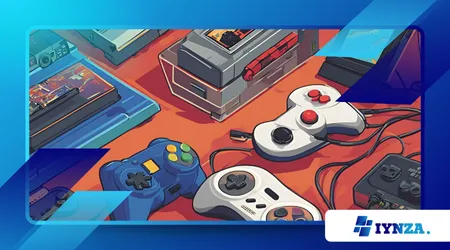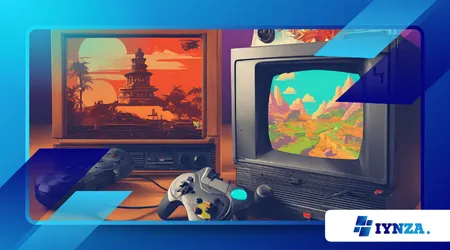Retro vs. Modern: Which Gaming Era Reigns Supreme?

The debate between retro vs. modern gaming has never been more alive. As technology evolves, so do the ways we play, but which era truly reigns supreme?
Anúncios
Let’s dive into the heart of this timeless discussion, exploring the nuances, strengths, and weaknesses of both retro and modern gaming.
By the end, you’ll have a clearer picture of why both eras are essential to the gaming landscape and why the question of supremacy might be missing the point entirely.
The Nostalgia Factor: Why Retro Gaming Still Captivates
Retro gaming isn’t just about pixels and chiptunes; it’s a cultural phenomenon.
Games like Super Mario Bros. and The Legend of Zelda defined generations.
Their simplicity and charm remain unmatched, even as modern titles push the boundaries of technology. For many, retro games are more than entertainment—they’re a connection to the past.
Modern games often overwhelm with complexity. Retro titles, on the other hand, offer straightforward mechanics.
This accessibility keeps them relevant, even in 2025. Whether it’s the tight controls of Mega Man or the addictive gameplay of Tetris, retro games are easy to pick up but hard to put down.
Nostalgia plays a huge role. For many, retro games are a portal to childhood. They evoke emotions modern titles struggle to replicate, creating a timeless appeal.
The sight of a CRT TV or the sound of a Sega Genesis booting up can transport players back to simpler times.
But nostalgia isn’t the only factor. Retro games are also celebrated for their creativity. Limited by technology, developers had to think outside the box.
This led to iconic visuals and gameplay mechanics that remain influential today.
Games like Street Fighter II and Donkey Kong Country are still played competitively, proving their enduring appeal.
The retro gaming community is another reason these games remain relevant. From speedrunners to collectors, fans keep the spirit alive.
Events like RetroWorld Expo and the popularity of retro-inspired indie games show that the love for classic gaming isn’t going anywhere.
Also Read: The Future of Esports: Trends and Predictions for the Next Decade
The Power of Modern Gaming: Innovation and Immersion
Modern gaming is a technological marvel. With advancements like ray tracing, AI-driven NPCs, and VR, the immersion is unparalleled.
Games like Cyberpunk 2077 and Starfield push boundaries, offering experiences that were unimaginable just a decade ago.
The level of detail in modern titles is staggering, from lifelike facial animations to sprawling open worlds.
The rise of cloud gaming has revolutionized accessibility. Platforms like Xbox Cloud Gaming and NVIDIA GeForce Now let players enjoy AAA titles on any device, anywhere.
This has democratized gaming, making it easier than ever for people to dive into the latest releases without needing expensive hardware.
Modern games also excel in storytelling. Titles like The Last of Us Part II and Baldur’s Gate 3 deliver cinematic experiences, blending gameplay with emotional depth.
These games tackle complex themes and feature characters that feel real, thanks to advancements in writing and performance capture.
Another strength of modern gaming is its inclusivity. Features like customizable controls, subtitles, and diverse representation ensure that more people can enjoy gaming.
This focus on accessibility has broadened the audience, making gaming a truly global phenomenon.
The social aspect of modern gaming can’t be ignored. Multiplayer games like Fortnite and Call of Duty bring millions together, creating shared experiences that transcend borders.
Whether it’s teaming up with friends or competing in esports, modern gaming fosters connections like never before.
See how interesting: The Art of Modding: How to Customize Your Gaming Experience
Graphics: A Tale of Two Eras

Retro games relied on pixel art, a style now celebrated for its creativity. Limited by technology, developers crafted iconic visuals that remain influential.
Games like Super Metroid and Chrono Trigger are still praised for their art direction, proving that great design transcends technical limitations.
Modern games boast photorealistic graphics. Titles like Horizon Forbidden West and Alan Wake 2 showcase what’s possible with today’s hardware, blurring the line between game and reality.
The level of detail in these games is staggering, from realistic lighting to intricate textures.
Yet, pixel art isn’t dead. Indie games like Celeste and Shovel Knight prove that retro aesthetics can coexist with modern design, appealing to both old and new audiences.
These games show that graphics are just one part of the equation—gameplay and creativity matter just as much.
The evolution of graphics has also changed how we experience games. Retro games relied on imagination to fill in the gaps, while modern games aim to create fully realized worlds.
Both approaches have their merits, and the choice often comes down to personal preference.
Interestingly, modern technology has also made retro gaming more accessible. Emulators and remasters allow players to experience classic games with enhanced visuals and performance.
This has introduced a new generation to the joys of retro gaming, ensuring its legacy continues.
+ See how interesting: Hidden Gems: Underrated Indie Games That Deserve Your Attentions
Gameplay: Simplicity vs. Complexity

Retro games thrived on simplicity. Controls were intuitive, and objectives were clear. This made them easy to pick up but hard to master, a formula that still works.
Games like Pac-Man and Space Invaders are timeless because of their straightforward yet challenging gameplay.
Modern games often feature intricate systems. From open-world exploration to deep RPG mechanics, they offer vast experiences.
However, this complexity can alienate casual players. Titles like Elden Ring and The Witcher 3 are celebrated for their depth, but they can also be overwhelming for newcomers.
The balance lies in choice. Some prefer the straightforward fun of retro games, while others crave the depth of modern titles.
Both have their place in gaming history, and the best games often find a way to blend the two.
One area where modern gaming excels is player agency. Games like Baldur’s Gate 3 and Disco Elysium offer branching narratives and meaningful choices, giving players a sense of control over the story.
This level of interactivity was rare in retro games, which often followed linear paths.
However, retro games had their own strengths. The lack of tutorials and hand-holding forced players to learn through trial and error.
This created a sense of accomplishment that’s harder to replicate in modern games, where guidance is often built into the design.
Community and Culture: Retro vs. Modern
Retro gaming has a passionate community. From speedrunners to collectors, fans keep the spirit alive.
Events like RetroWorld Expo and the popularity of retro-inspired indie games show that the love for classic gaming isn’t going anywhere.
Modern gaming fosters global connections. Multiplayer games like Fortnite and Call of Duty bring millions together, creating shared experiences that transcend borders.
Whether it’s teaming up with friends or competing in esports, modern gaming fosters connections like never before.
Both eras have shaped gaming culture. Retro games laid the foundation, while modern games continue to innovate, ensuring the industry’s growth and diversity.
The rise of streaming and content creation has also changed how we engage with games, creating new opportunities for community building.
Interestingly, the lines between retro and modern communities are blurring. Many modern gamers grew up with retro titles, and their love for classic games often influences their tastes.
This cross-generational appeal ensures that both eras remain relevant.
The cultural impact of gaming can’t be overstated. From memes to merchandise, gaming has become a cornerstone of pop culture.
Whether it’s the iconic sound of Super Mario or the viral dances of Fortnite, gaming continues to shape how we connect and express ourselves.
The Economic Impact: Then and Now
Retro gaming is big business. Rare cartridges and consoles fetch thousands at auctions.
The demand for retro-inspired hardware, like the Analogue Pocket, shows no signs of slowing. Collectors and enthusiasts drive this market, proving that old-school appeal still sells.
Modern gaming dominates the market. In 2025, the industry is projected to surpass $250 billion, driven by blockbuster releases and microtransactions.
The financial stakes are higher than ever, with companies investing billions in development and marketing.
Yet, retro gaming’s economic impact shouldn’t be underestimated. It’s a niche market, but one with significant influence.
The success of retro-inspired games and hardware shows that there’s still a demand for classic experiences.
The rise of digital storefronts has also changed the economic landscape. Retro games are now more accessible than ever, with platforms like Nintendo Switch Online offering libraries of classic titles.
This has introduced a new generation to the joys of retro gaming, ensuring its legacy continues.
Interestingly, the retro vs. modern debate also influences game design. Many modern games draw inspiration from retro titles, blending old-school mechanics with modern innovation.
This cross-pollination ensures that both eras continue to shape the future of gaming.
Accessibility: Who Wins?
Retro games are often harder to access. Original hardware is scarce, and emulation raises legal and ethical questions.
Still, re-releases on modern platforms help bridge the gap, making classic games more accessible than ever.
Modern games are more accessible than ever. Digital storefronts, subscription services, and cross-platform play ensure that players can enjoy their favorite titles with ease.
This has democratized gaming, making it easier for people to dive into the latest releases.
However, accessibility isn’t just about availability. It’s also about inclusivity. Modern games lead here, with features like customizable controls and diverse representation.
This focus on accessibility has broadened the audience, making gaming a truly global phenomenon.
Interestingly, retro games are also finding new life through accessibility features.
Remasters and remakes often include options like save states and rewind functions, making classic games more approachable for modern audiences.
The debate over accessibility highlights the strengths and weaknesses of both eras. While modern games excel in inclusivity, retro games offer a unique charm that continues to resonate with players.
The Future: Bridging the Gap
The line between retro and modern is blurring. Hybrid titles like Sea of Stars and Octopath Traveler combine retro aesthetics with modern mechanics, appealing to both camps.
These games show that the best of both worlds is possible, creating experiences that honor the past while embracing the future.
Remakes and remasters also bridge the gap. Games like Final Fantasy VII Remake and Metroid Dread reintroduce classic franchises to new audiences, honoring their roots while embracing innovation.
These titles show that retro and modern gaming can coexist, creating a rich and diverse landscape.
As technology advances, the gaming landscape will continue to evolve. Yet, the retro vs. modern debate will persist, fueled by passion and nostalgia.
The future of gaming lies in finding a balance between innovation and tradition, ensuring that both eras continue to thrive.
Conclusion: A Timeless Rivalry
The retro vs. modern gaming debate isn’t about choosing a winner. It’s about celebrating the diversity of an ever-evolving medium.
Both eras have shaped gaming into what it is today, and both will continue to influence its future.
Whether you’re a fan of 8-bit classics or cutting-edge AAA titles, one thing is clear: gaming is a universal language.
And in 2025, it’s more vibrant than ever. The retro vs. modern debate is a testament to gaming’s rich history and bright future, reminding us that there’s room for both in this incredible medium.
Table 1: Retro vs. Modern Gaming Comparison
| Aspect | Retro Gaming | Modern Gaming |
|---|---|---|
| Graphics | Pixel art, limited by hardware | Photorealistic, advanced tech |
| Gameplay | Simple, intuitive mechanics | Complex, immersive systems |
| Accessibility | Limited, reliant on old hardware | Widely available, digital-first |
| Community | Niche, passionate fanbase | Global, connected multiplayer |
| Economic Impact | Niche market, collectibles | $250 billion industry, microtransactions |
Table 2: Top Retro and Modern Games (2025)
| Retro Games | Modern Games |
|---|---|
| Super Mario Bros. | Cyberpunk 2077 |
| The Legend of Zelda | Starfield |
| Pac-Man | The Last of Us Part II |
| Tetris | Baldur’s Gate 3 |
| Sonic the Hedgehog | Horizon Forbidden West |
Frequently Asked Questions (FAQs)
1. What defines a retro game?
Retro games are typically those released before the mid-2000s, often characterized by pixel art, chiptune music, and simpler gameplay mechanics.
2. Are modern games better than retro games?
It depends on personal preference. Modern games offer advanced graphics and complex systems, while retro games are celebrated for their simplicity and nostalgia.
3. Can I still play retro games today?
Yes! Many retro games are available through digital storefronts, remasters, and retro-inspired consoles like the Analogue Pocket.
4. Why are retro games so expensive?
Rarity and demand drive up prices for original retro games and hardware, especially for rare or well-preserved items.
5. What’s the future of retro gaming?
Retro gaming will continue to thrive through remakes, remasters, and indie games that draw inspiration from classic titles.
6. How has modern gaming improved accessibility?
Modern games often include features like customizable controls, subtitles, and diverse representation to make gaming more inclusive.
7. Are there any downsides to modern gaming?
Some players find modern games overly complex or reliant on microtransactions, which can detract from the experience.
8. Can retro and modern gaming coexist?
Absolutely! Many gamers enjoy both eras, and hybrid titles that blend retro aesthetics with modern mechanics are increasingly popular.
In the end, the retro vs. modern debate is a testament to gaming’s rich history and bright future.
Both eras have their strengths, and together, they ensure that gaming remains a dynamic and inclusive art form.
Whether you’re a fan of the classics or the latest releases, there’s something for everyone in the world of gaming.
